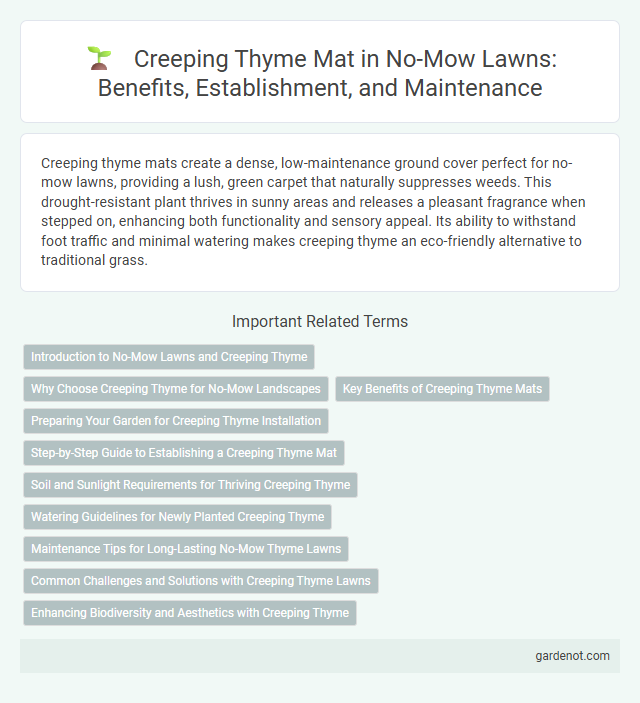Creeping thyme mats create a dense, low-maintenance ground cover perfect for no-mow lawns, providing a lush, green carpet that naturally suppresses weeds. This drought-resistant plant thrives in sunny areas and releases a pleasant fragrance when stepped on, enhancing both functionality and sensory appeal. Its ability to withstand foot traffic and minimal watering makes creeping thyme an eco-friendly alternative to traditional grass.
Introduction to No-Mow Lawns and Creeping Thyme
No-mow lawns offer an eco-friendly alternative to traditional grass by reducing water use and maintenance. Creeping thyme mat thrives as a low-growing, fragrant ground cover that naturally suppresses weeds and attracts pollinators. Its drought tolerance and resilience make creeping thyme an ideal choice for sustainable landscaping with minimal mowing requirements.
Why Choose Creeping Thyme for No-Mow Landscapes
Creeping thyme mat provides a resilient, low-maintenance ground cover ideal for no-mow landscapes due to its drought tolerance and ability to thrive in poor soils. Its dense growth suppresses weeds naturally, reducing the need for herbicides and frequent upkeep. The aromatic foliage and vibrant flowers enhance aesthetic appeal while supporting local pollinators, making it an eco-friendly choice for sustainable lawns.
Key Benefits of Creeping Thyme Mats
Creeping thyme mats provide a durable, low-maintenance ground cover that suppresses weeds and reduces lawn mowing requirements. Their dense, aromatic foliage attracts pollinators like bees and butterflies, enhancing garden biodiversity. Resistant to drought and foot traffic, these mats offer an eco-friendly alternative to traditional grass lawns while maintaining aesthetic appeal.
Preparing Your Garden for Creeping Thyme Installation
Preparing your garden for creeping thyme installation involves thoroughly clearing the area of existing grass and weeds to ensure optimal soil contact. Loosen the soil with a rake or tiller to create a fine, well-drained bed, improving root establishment and growth. Testing the soil pH to maintain a slightly acidic to neutral range (6.0 to 8.0) supports thriving creeping thyme mats for a low-maintenance no-mow lawn.
Step-by-Step Guide to Establishing a Creeping Thyme Mat
To establish a creeping thyme mat, start by preparing well-drained, sandy soil and removing existing grass or weeds. Space the thyme plants about 6 to 12 inches apart, watering them regularly until they are fully established, usually in 8 to 12 weeks. Once mature, the dense mat requires minimal maintenance and thrives with occasional trimming and infrequent watering, making it an ideal low-maintenance, no-mow lawn alternative.
Soil and Sunlight Requirements for Thriving Creeping Thyme
Creeping thyme thrives in well-drained, sandy or loamy soil with a neutral to slightly alkaline pH between 6.0 and 8.0. This low-maintenance ground cover requires full sun exposure, at least 6 to 8 hours daily, to promote dense, vibrant growth and prevent leggy stems. Optimal soil drainage combined with ample sunlight ensures robust blooming and resilience against fungal diseases in no-mow lawn applications.
Watering Guidelines for Newly Planted Creeping Thyme
Newly planted creeping thyme requires consistent watering to establish a strong root system, ideally receiving about 1 inch of water per week, either through rainfall or supplemental irrigation. Water deeply but sparingly, allowing the soil to dry slightly between watering sessions to prevent root rot and promote healthy growth. Early morning watering is recommended to reduce moisture on foliage and minimize fungal diseases while ensuring optimal soil hydration.
Maintenance Tips for Long-Lasting No-Mow Thyme Lawns
Creeping thyme mats require minimal maintenance, making them ideal for no-mow lawns by thriving with occasional watering and infrequent trimming to preserve dense ground cover. To ensure long-lasting health, avoid heavy foot traffic and aerate soil annually to promote root growth and prevent compaction. Applying a balanced, slow-release fertilizer in early spring enhances vigor and supports vibrant foliage throughout the growing season.
Common Challenges and Solutions with Creeping Thyme Lawns
Creeping thyme lawns often face challenges such as weed invasion, uneven growth, and drought stress due to their low-growing nature and slow initial establishment. Regular maintenance including proper soil preparation, mulching to suppress weeds, and consistent but moderate watering helps ensure a dense, healthy mat. Overcoming patchiness requires reseeding bare spots in early spring and avoiding heavy foot traffic to promote vigorous growth and resilience.
Enhancing Biodiversity and Aesthetics with Creeping Thyme
Creeping thyme mat serves as a low-maintenance, no-mow lawn alternative that significantly enhances biodiversity by attracting pollinators such as bees and butterflies. Its dense, aromatic foliage not only suppresses weeds but also adds vibrant color and texture to landscapes, improving overall aesthetics. Choosing creeping thyme for ground cover supports sustainable gardening practices while creating visually appealing, eco-friendly outdoor spaces.
Creeping thyme mat Infographic

 gardenot.com
gardenot.com